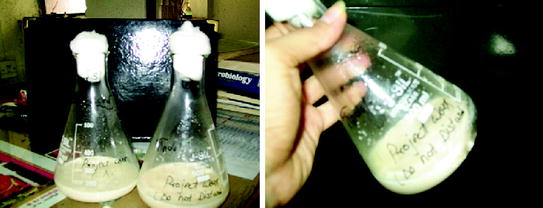Fig. 2.1
Multiple plates
Latter these microbes were harvested into the natural media like pasteurised milk of cow and buffalos.
2.3 Methodology
The exact four procedure applied to generate the formulation as follows.
2.3.1 Part A
The milk of cow/buffalo were pasteurised before use to nil the other microbes if present in the milk. The pasteurization and tyndallisation gave the platform to the new inoculated microbes to get flourish into the milk after cooling of this milk. Tyndallisation was carried out in beaker for 3 days and then microbes were inoculated to get semi-solids beads (Fig. 2.2).


Fig. 2.2
Plate of MRS
2.3.2 Part B: Homogenization and Spray Dry
This semi-solid mass obtained by 24 h incubation in oven were broken down/converted into liquid state by Homogenization. 2,300 rpm (rotation per min) used to break the bead/semi solid mass formation. The spray-drying process of Lactobacilli Species in the various media was undertaken in a laboratory scale spray dryer (Jisl mini-spray dry). The excipients used for the spray dry were lactose and starch solution. This combination of lactose and starch (2:1) acts as the thermo-protective agent to prevent the mortality of the microbes or decrease in the cell count while at the spray dry procedure due to the heavy inlet temperature. The viability at different combination were carried out for lactose and starch solution as 1:1, 1:2, 2:1 etc. to check for good results (Fig. 2.3).


Fig. 2.3
Spray dry JISL
2.3.3 Part C: In Vitro Cytotoxicity Studies: SRB Assay
Cell line: Colon cancer HT-29 procured from (N.C.C.S) National Centre for Cell Science, Pune. Standard anticancer drug Capacitabin obtained as gift sample from the Atmatara foundation and research unit (Kolhapur). Stock solution of Lactobacillus model moiety powder of 1 mM in 0.25 % Dimethyl sulphoxide (DMSO) was prepared and further dilution done in 10, 50 and 100 µM with phosphate buffer saline (PBS). Stock solution of Capecitabine of 1 mM in distilled water was prepared and further dilution done in 10, 50 and 100 µM with phosphate buffer saline (PBS).
2.3.4 Part D: Anti-microbial Screening (Well Assay)
MRS agar plates were prepared; that surface of the MRS agar plates was inoculated with the swab containing 24 h culture V. cholera and for S. dysentriae. Wells were punched with the gel puncher 80 mg Lactobacillus model moiety powder (L.A.P.) were added to the wells punched in the centre of the plates. Plates were incubated for 24 h at 37 °C. S. dysentriae were also incubated on the MRS agar plates, separately and wells were punched. Wells, with a diameter of 5 mm, then cut in the agar using sterile gel puncher.
2.4 Results and Discussion
The results for the Part A work were in form of the CFU (colony forming units) count as,
Count in Milch animals
(a)
Cow = 106 CFU/ml (colony forming units).
(b)
Buffalos = 107 CFU/ml (colony forming units).
This difference in the cell count was due to the difference in the fat, nutrients avail in both animals milk (Fig. 2.4).


Fig. 2.4
CFU count in semi solids mass form in beaker
The results for the Part B and Part C work were obtained in form liquid generated at the rotation per min (rpm) via Homogenization carried out from 1,000 to 2,300 rpm. The results seen in case at 2,300 rpm for 20 min were optimal. This solution obtained by this above procedural was acceptable for the next spray dry mythology. The large size particle generally clogged the spray dry at the gun nozzle but size reduction at 2,300 rpm for 20 min prevented the above discussed problem.
The spray drying carried out by taking the combination of the Lactose and starch in different ratios and the cell count obtained by serial dilution for the cow milk is given in Table 2.1.
Table 2.1
Batch dilution at 106 CFU/ml by plate count for the cow milk
Sr. no. | 1:1 | 1:2 | 2:1 |
|---|---|---|---|
1 | 12 | 15 | 35 |
2 | 12 | 14 | 34 |
3 | 12 | 14 | 34 |
The results were optimal for the cow milk as by spray dry. The 2:1 ratio of (lactose and starch) gave good cell count as 35 × 106 CFU/ml (average).
Similarly, the spray drying carried out by taking the combination of the Lactose and starch in different ratios and the cell count obtained by serial dilution for the Buffalo milk is given in Table 2.2.
Table 2.2
Batch dilution at 106 CFU/ml by plate count for the buffalos milk
Sr. no. | 1:1 | 1:2 | 2:1 |
|---|---|---|---|
1 | 12 | 14 | 21 |
2 | 12 | 15 | 21 |
3 | 12 | 14 | 22 |
The results were optimal for the Buffalos milk as by spray dry. The 2:1 ratio of (lactose and starch) gave good cell count as 21 × 106 CFU/ml (average).
2.4.1 Other Thermo Protective Agent Used and There Effects Observed by Spray Dry
The spray dry results obtained in case of the Lactose alone or starch alone is not so good than lactose and starch used in combination at (2:1) ratios is given in Table 2.3.
Table 2.3




Other thermo protective agent used and there effects
Stay updated, free articles. Join our Telegram channel

Full access? Get Clinical Tree


